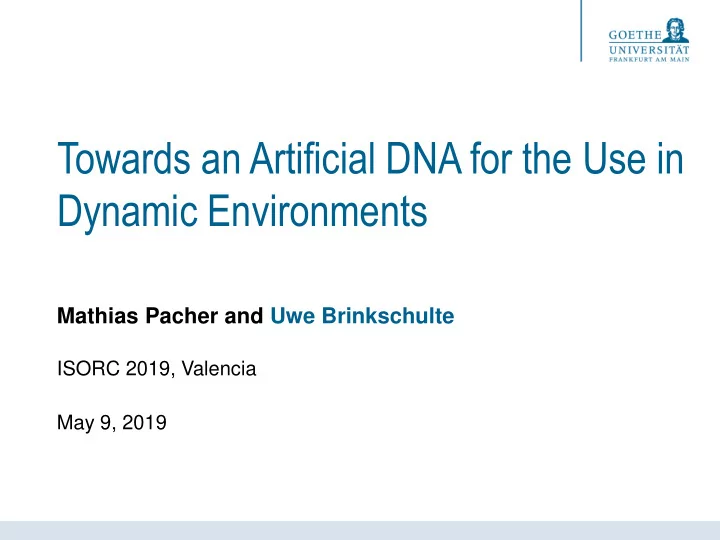

Towards an Artificial DNA for the Use in Dynamic Environments Mathias Pacher and Uwe Brinkschulte ISORC 2019, Valencia May 9, 2019
1. Motivation Current ICT systems : • Increasingly complex Distributed • • Interconnected Dynamic environments • ➔ Thus, Development and maintenace are hard • • Failures at run-time Idee of Organic Computing : • System adapts autonomously and dynamically to environment (Tomforde et al., „ Organic Computing in the Spotlight“, 2017) 1
2. Artificial Hormone System • Assignment of tasks to processors Application • Hormone-based control loops Tasks • Self-configuration Middleware • Self-improvement PZ PZ PZ PZ PZ PZ PZ • Self-healing PZ PZ PZ PZ PZ PZ PZ Create virtual organs • PZ PZ PZ PZ PZ PZ PZ PZ PZ PZ PZ PZ PZ PZ PZ PZ PZ PZ PZ PZ PZ PZ PZ PZ PZ PZ PZ PZ PZ PZ PZ PZ PZ PZ PZ Organs Brinkschulte, Pacher, von Renteln, An Artificial Hormone System for Self-Organizing Real-Time Task Allocation in Organic Middleware, Springer 2
3. Artificial DNA Idea : Most embedded systems consist of standard components • ➔ Describe components and interconnection as a text file ➔ Artificial DNA ➔ No programming, only parametrization ➔ Automatically determine tasks and hormone strength 1 = 70 (1:2.2) 100 25 // constant setpoint value, period 25 msec 2 = 1 (1:3.1) ‐ // ALU, control deviation (minus) 3 = 10 (1:4.1) 4 5 6 25 // PID (4, 5, 6), period 25 msec 4 = 600 1 // actor, resource id = 1 5 = 500 (1:2.1) 2 25 // sensor, resource id = 2, period 25 msec 3
4. Dependability In general: 𝑄 𝐵𝐸𝑂𝐵 ≤ 𝑄 𝑆𝑓𝑒. ➔ Interesting approach for automotive applications 4
5. Artificial DNA for dynamic environments Self-building system at run-time • • Easy to configure at run-time Scalable • ADNAs of different systems may merge and separate • 5
Example Red car: • ABS 1 Blue car (less computing power): ESP 1 • • ABS 2 • Motor control 1 ESP 2 • • Entertainment 1 • Motor control 2 … • Entertainment 2 • … • 6
Example Scenarios : 1. Stress test → Different car is in range each 1.5 seconds for 1.5 seconds 2. Replacement for failing processors → Different car is in range each 6 seconds for 4.5 seconds 7
Evaluation scenario 1 (stress test) • ADNA of red car complete 8
Evaluation scenario 1 (stress test) • Reaction time until ADNA is complete 9
Evaluation scenario 1 (stress test) • Speed and distance 10
Evaluation scenario 2 (Replacement for failing processors) • ADNA of red car complete 11
Evaluation scenario 2 (Replacement for failing processors) • Reaction time until ADNA is complete 12
Evaluation scenario 2 (Replacement for failing processors) • Speed and distance 13
Conclusion • First experiments with extended ADNA for dynamic systems • Stress test • Compensate failing processors Future work : • ADNA assignment priorities Conditional ADNA • Unconditional part Conditional part Then : • Paywall for automotive applications 14
Thank you Questions? 15
Recommend
More recommend